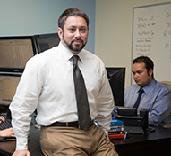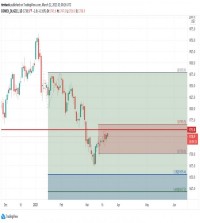|
By Mark Melin ‚ 
Cole Wilcox
At first glance, newly minted managed futures mutual fund managers Cole Wilcox (right) and Eric Crittenden (left) of Longboard Asset Management might seem like an odd combination. Both were featured together in Michael Covel's The Little Book of Trading (Wiley 2011), which chronicles the history of their firm Longboard. However, Mr. Wilcox is the firm's strategic thinker and visionary, a strong communicator who can engage any audience in a discussion of why their trend following approach works. Mr. Wilcox often speaks of his and Mr. Crittenden's many years of research, which resulted in publications such as "The Capitalism Distribution." (2008). On the other hand, Mr. Crittenden is the analytical, mathematical mind, who considered studying meteorology as a child because of an extreme interest in physics and the dynamics of weather. "I didn't have the good looks to be a weather man," he quips. "It wasn't until my passion for data analytics met the world of trading and managed futures that I found my calling." ‚ 
Eric Crittenden
As the fund's orator, Mr. Wilcox is a rare mutual fund executive who spends four days a week traveling the country, individually meeting with Registered Investment Advisors (RIAs) and Broker Dealers (BDs), to educate and promote the virtues and merits of Longboard's recently launched managed futures mutual fund. "I saw an amazing track record, but really couldn't believe it was sustainable. I spent a lot of time analyzing his trend following fund, talking with them, reviewing their audits, asking a lot of questions about their process, understanding their whole philosophy and approach to trading." ‚ "Although Longboard and the mutual fund are just emerging, my background and history is in managed futures. I started as an allocator, first meeting Salem Abraham (founder of well known trend following CTA Abraham Trading) in 2000. I saw an amazing track record, but really couldn't believe it was sustainable. I spent a lot of time analyzing his trend following fund, talking with them, reviewing their audits, asking a lot of questions about their process, understanding their whole philosophy and approach to trading. During this time I was working at a multi-strategy hedge fund and convinced them to invest in this opportunity called managed futures. "Abraham Trading was the first CTA we allocated towards at a time when managed futures was a backwater of the alternative investment industry."‚ When Mr. Wilcox made his first managed futures allocation, industry assets under management were hovering just above $40 billion.‚ Today the industry has become the fastest growing hedge fund sub-category at over $325 billion, according to BarclayHedge. In 2001 the decision to invest in a relatively unknown alternative investment opportunity might have accompanied some career risk, but Mr. Wilcox nonetheless persevered. "It wasn't like it is today where companies like Morningstar have a category for managed futures." "Going forward I traveled the world investigating elite managed futures managers like David Harding from Winton. In addition, Eric and I started managing money for the well-known currency trader Tom Basso. I've seen the common denominating factors of success and failure in doing this intense due diligence component. When managers are smaller sometimes you can really get unique insights into what's going on, if you can ask very good questions, you can get very deep answers." The Capitalism Distribution Drives Trend Following Strategy The underlying principles of Mr. Wilcox and Mr. Crittenden's managed futures trend following strategy are fairly simple, but maybe a bit unintuitive. Empirical evidence shows that most competitive systems share a common, interesting distribution of success and failure, according to the duo. "We find that a relatively small number of massive top and bottom performance is ultimately responsible for the aggregate results. Intuitively we tend to think that most competitors are average and that extreme winners and losers are the exception. However, the research shows that success and failure is not distributed in a normal 'bell curve.'" "What we found doing this trend following research in equities is an amazing statistic. The best 5% performing stocks, in any given year, are responsible for a large portion of market gain." "What we found doing this trend following research in equities is an amazing statistic. The best 5% performing stocks, in any given year, are responsible for a large portion of market gain," Mr. Wilcox observed. "If each year, for the last 20 years, an investor missed the top 5% performing stocks and instead owned the other 95% of the market, he or she would have lost money as an investor. Similarly, if you randomly bought a stock and held it over the last 20 years, there is a one in five chance that the investment would have lost 100% of its equity value. We observed that nearly 20% of all stocks that went public eventually lost all their value for shareholders.‚ So we have 5% of stocks that are really moving the needle each year and an extraordinarily large number of stocks that are doomed investments. This is not a normal bell curve distribution; it is a distribution that has very fat tails in terms of the numbers winners and losers. These extreme performers are there, each and every year, and they have a phenomenal impact on the market." This concept is not unique to just the world of stocks. When Mr. Crittenden and Mr. Wilcox investigated other competitive systems, they found similar results. "Let's use the NBA as an example," Mr. Wilcox observed. "You have a minority of elite players who significantly outscore the remaining majority. Every game, these few players are credited with carrying the rest of the team. Ultimately, the results of the game are dependent on how the super stars play. This is not a normal distribution; this is something that has more of a winner take all type of distribution." "Italian economist Vilfredo Pareto observed that 80% of the wealth was owned by 20% of the population. Curiously, he also noticed that 20% of pea pods produced about 80% of the peas. This law of the vital few became known as Pareto's law and remains a common rule of thumb in many different fields." This principal is used to drive part of the Longboard trend following algorithm. Research in fields like economics, biology, and sociology agree with Mr. Wilcox and Mr. Crittenden's fundamental understanding of competitive systems. In the early 20th century the Italian economist Vilfredo Pareto observed that 80% of the wealth was owned by 20% of the population. Curiously, he also noticed that 20% of pea pods produced about 80% of the peas. This law of the vital few became known as Pareto's law and remains a common rule of thumb in many different fields. Today, the availability of performance data allows researchers to explore many different competitive systems. A recent study in the Journal of Personnel Psychology reveals that extreme performance is common. For instance, the authors of the study found that a large percentage of NBA career points are attributable to a minority of world class athletes, a small group of career politicians will serve a disproportionate number of terms, a shocking number of scholarly publications are produced by a few elite academics, and the bulk of award nominations go to a clique of superstar entertainers. To expand their own research, Mr. Wilcox and Mr. Crittenden decided to investigate other financial markets besides US stocks. "To exploit this profit opportunity, investors need to ignore the average performance, the majority of assets that essentially net out to nothing. Focus your attention on where the marginal impact is coming from, the substantial persistent under performance and substantial persistent out performance that is in the minority." "Imagine you have a portfolio of 108 global futures markets representing all the asset classes: stocks, bonds, currencies, and interest rates. When you look at the year over year risk adjusted returns, the January to December movements that affect the profit and loss of your portfolio, you find a similar distribution of performance as was found in US stocks. There is a small minority of very large persistent outperformance and a very small minority of persistent substantial under performance. The majority of markets net out to practically nothing when it comes to end of year performance. To exploit this profit opportunity, investors need to ignore the average performance, the majority of assets that essentially net out to nothing. Focus your attention on where the marginal impact is coming from, the substantial persistent under performance and substantial persistent out performance that is in the minority. This is the strategic underpinning of our trend following strategy." How do you take this vision and practically build an investment strategy around it? "We create a look back window that basically takes the last 18 months of data, the closing prices over the last 18 months, looking at the prices of assets (in 108 markets)," Mr. Wilcox notes. "So if today's price is above some level, say the 99th percentile of the previous18 months of closing prices, we will be long that market. If today's price is below 99% of all the closing prices we will be short that market. For every market that is in the middle, the 50th percentile, where today's price is at the median closing price over the last 18 months, we will fold open positions and will continue to be flat those markets. By definition, if a market was in the middle of the pack over the last 18 months, it is not a persistent outperformer or underperformer. In order to utilize our capital and risk budget wisely, we seek to limit our exposure to these types of investments." Managing Loss Exposure It is important to note that Longboard has zero predictive edge, according to Mr. Wilcox. "The strategy is to buy breakouts, sell breakdowns, hold winners, fold losers. It doesn't have an edge in that it is essentially a 50/50 proposition. Half the trades we make money on, half we don't. We can lose when we have breakouts and they turn out to be false positives. People say, 'How can you make money if this doesn't have a predictive edge?' This is because the function of the win / loss ratio is not as important as the asymmetry in the payoff structure." "How can you make money if this doesn't have a predictive edge? This is because the function of the win / loss ratio is not as important as the asymmetry in the payoff structure." It is here the focus on size of loss rather than win percentage comes into play, and Mr. Wilcox uses a simple coin flip analogy. "The design is to gain on average $3 for every $1 we lose on these trades. The coin flip might be 50/50 but it can be a bias coin in that we strive to win $3 and lose $1. In order for you to win you have to find an edge that you can systematically and continually repeat because there is always a loser on the other side of the trade. The way we do this is we take trades based on an actuarial process. We understand the distribution of markets; we take positions and participate in markets in an actuarial way." While understanding probability and actuarial tables is interesting, the Longboard team notes there are no imbedded guarantee. "You can still blow yourself up and actually lose money if you deploy too much risk.‚ If your goal is to grow your wealth, you have to understand the math of compounding. Losses affect the compounding of your account more than the gains. If I lose 50%, I now have to make a 100% return to break even. We are very focused on controlling downside risk, particularly the risk of catastrophic losses. The way that I define risk isthe permanent loss of capital.‚ So if we bet heads and I flip 50 coins simultaneously and they all come up tails, I want to know how much money in advance I will have lost. Although the probability is small that 50 flipped coins will all come up tails, such an event will seriously interrupt compounding and can negate years upon years of great performance." Risk Management and Portfolio Position Sizing "The way we go about position sizing the portfolio is that we start with a risk budget, and the risk budget is designed to protect compounding in the event that all of our positions move against us. Then, we distribute portions of the risk budget to each position and size the position according to the difference between the current price and the 50 percentile stop loss, the point where we will fold the bet. Each day, the market will go by and we will have new trades and will mark to market the profit and loss of all of our open positions. Every day, the distance between the current price and the rolling 50th percentile stop loss is changing. This means that the position's risk is also constantly changing. "Slowly, the aggregate risk we are assuming on all of our trades may become really far from our initial, optimal risk budget. If positions become much more volatile, the distance between the current price and all of our stops will grow and our total risk budget may rise from the optimal level to something much higher. This means we have to reduce some positions in order to fit back into the risk budget.‚ Now I'm not shooting the positions down because I think that the trend is going to end, but I have risk budget that I have to honor if I want to maximize compounding. To a compounder, risk is a finite resource. We are trying to be efficient in regards to the risk we take verses the reward we receive. Effective money management is really a skill of efficient risk allocation; it's not a skill of trying to find return. We are disciplined and systematic in our management of risk. Investors who want to thrive can't afford to lose the money that they need to survive." The Risk of Directionless Volatility When considering market environments, Mr. Wilcox notes his most pressing issue.‚ "I'm very concerned about a directionless volatility environment.‚ An environment like we've had for the last 18 months is an example of a global directionless volatility. You don't get any sustained directional movement one way or another." "We don't want to be over exposed to the whip saw of directionless volatility where you have trend following strategies that are always buying every short term breakout and selling every short term breakdown." Now he brings the conversation down to an anecdotal level. "It's similar to a pro surfer. You can have all the skill in the world, but if the underlying physics of the wave doesn't form then there is nothing you can do to apply your skills after capturing the wave. But there is something you can control. You can control whether or not whether or not you expend all your energy trying to make a wave form. If you accept the fact you don't control whether or not the waves are forming you can be disciplined and just wait and be patient. In our case this is kind of how we view things. We don't want to be over exposed to the whip saw of directionless volatility where you have trend following strategies that are always buying every short term breakout and selling every short term breakdown. Longboard is exclusively focused on capturing the 'big wave' movement of persistent ultra-long duration winners and losers." Solving A Need It has long been known that diversifying traditional portfolios with alternatives investments like a managed futures allocation provides tremendous benefit, particularly during large market dislocations like the recent global credit crisis. Unfortunately, managed futures exposure has been mostly limited to large institutions and high net individuals who qualify for and can afford the costly private placements with CTAs. For the most part, managed futures strategies have been unavailable to registered investment advisors (RIAs). "Managed futures mutual funds provide RIAs with a cheaper and easier way to get exposure to managed futures," Mr. Wilcox says. "However, not all managed futures mutual funds are created equal. Many mutual funds pool investor money to operate an off-shore fund of funds. This fund of funds invests in external CTAs who operate the fund's managed futures strategies. At the end of the year, these CTAs often charge the mutual fund large fees that are ultimately passed on to the RIA. These fees are often hidden from the RIA, who is only aware of the fees levied by the mutual fund provider. In addition, because the fund of funds operates as a foreign entity, trading profits are taxed at unfavorable rates."While the fund of fund concept does have the benefit of diversification from individual manager risk, something mentioned in the book High Performance Managed Futures, there are several areas where the Controlled Foreign Corporation (CFC) can hinder the elegance of the product's design. In comparison, Longboard's managed futures mutual fund provides RIA's direct access to Longboard's managed futures strategy for a low cost with no hidden fees. In addition, the strategy is largely run from domestic accounts, meaning trading profits are taxed at more favorable rates. Longboard Asset Management is committed to providing the best mutual fund offering to RIAs. For additional performance and risk evaluation regarding the Longboard program, send an e-mail to melin@opalesque.com. |
|
This article was published in Opalesque Futures Intelligence.
|





 RSS
RSS











